Family : Apodidae

Text © Dr. Gianfranco Colombo

English translation by Mario Beltramini
When Antonio Pigafetta came back on the mainland in 1521, after three years of circumnavigation around the world with Magellan’s mission, had with him a logbook with exceptional news. Surely not an expert of ornithology but good and punctual reporter, he referred of having been able to see in the “spices seas”, those birds that lived in heaven always suspended in air without ever touching the soil, if not when they died and only by that time they were collected by the human beings.
These were the Birds of paradise, whose first specimens known and carried by the Dutch in Europe, had been deprived of their legs and of part of the wings by the local natives, due to a particular use as ornament of their costumes. A guess later on confirmed then by the scientific name given to one of the nicest species of paradisaea, the biggest, (Paradisaea apoda), rightly from a-pous = without feet. If around this bird a legend had generated, proved later logically as such, that reported of a life spent always in air, in the reality exists instead a group of birds that perfectly applies this style of life, spending all their existence in flight without touching the soil if not rarely: the common swifts.
The Common swift (Apus apus Linnaeus, 1758) belongs to the order of the Apodiformes and to the family of the Apodidae, being this last a term returning quickly to the aforementioned references. These birds during the first two year of their life will not even approach the land and only when they will feel the necessity of nesting, will get down for the first time to touch it. For them, indefatigable flying beings, that will be a real “baptism of the earth”!
Actually, the beginning of the reproductive activity often goes well beyond the second year of life, mainly due to the scarcity of sites where to place the nest, hence the period of uninterrupted flight exceeds often the biennium. In fact, this bird, one of the greatest experts in the flight, eats, drinks, mates and sleeps in air. But let us see what actually causes this avian activity to the bird.
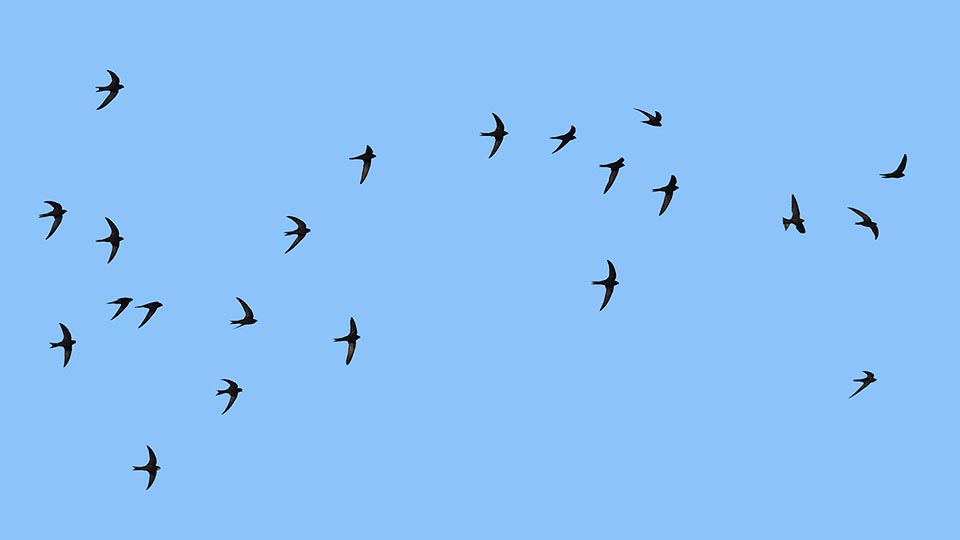
The Common swifts (Apus apus) spend usually nine months in the winter quarters and three months in the sites of nesting of the boreal hemisphere. They arrive by April, shouting like crazy little devils with whirling laps around the belfries, to again migrate south with the young starting from the second half of July © Gianfranco Colombo
The Common swift flies horizontally at an average speed of about 90 km/h with unbelievable points of more than 200 km/h and slowdowns to 50 km/h: as we shall see its wing conformation does not allow, in days without wind, low speeds in order not meet standstills and loss of lift. At a markedly comfortable speed, the common swift can consequently cover with absolute serenity, not less than 1.000 km per day! It is sufficient to think that during the nesting time the feeding sites may be located even at 100 km of distance from the nest. In order to understand the enormity of these data, we can quite easily imagine that a Milanese common swift can go all the days to Rome hunting gnats and gets back in the evening in its native skies. Assuming that during the migrations or during the standing in the winter quarters it limits to these distances, even if it is possible to think that it can cover a major distance, one thousand kilometres per day mean 360.000 per year.
Keeping then in mind that the Common swift is a very long-lived bird, (Swedish scientists have reported a case of recapture of a specimen ringed even 17 years before, but others have ascertained even ampler instances), it is easy to imagine that a small Common swift one day gets out from the crevice where it was born and from where has been hardly able to observe what was surrounding it and suddenly, with no experience at all, it jumps into the void below and starts flying for three years, wandering around the world without ever stopping! This is not easy to understand for us, humans, so much linked to the earth we have well firm under our feet!
The etymology of the scientific binomen Apus comes, as previously mentioned, from “a” = without and “pous” = feet, repeated in the genus as well as in the species, rightly due to the reduced length of the legs. The common Italian name of Rondone seems to come from the Latin term “hirundo” = swallow, in an augmentative version. Some trace it back from the Spanish “rondar” = to wander, due to their whirling flights around the nesting sites.
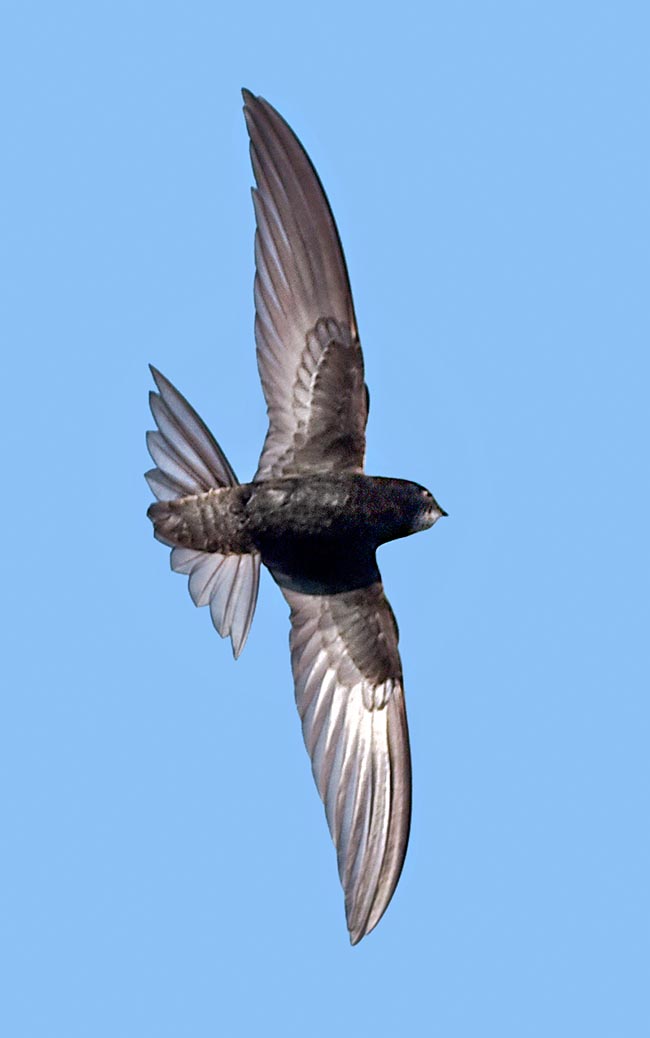
Zooming with open tail. They exceed the 200 km/h, hunting mosquitoes, ephemerals and other small insects © Gianfranco Colombo
In Europe it is called Common swift in English, Mauersegler in German, Vencejo Común in Spanish, Martinet noir in French, Andorinhão preto in Portuguese and a nice Yo-Roppaamatsubame in Japanese.
Zoogeography
All world populations of this bird, winter in Southern Africa, well under the Equator.
Conversely, it nests in a very vast area covering in its totality the European continent, but Iceland, all Siberia up to the Pacific Ocean, going southwards up to the 40th parallel and in a belt that from the Middle East reaches the Indian subcontinent south of the big Himalayan chains.
It is also present in the north-western part of Africa, from Morocco to Tunisia.
Usually, the Common swift spends nine months in the winter quarters and three in the nesting areas: it is one of the migrators that delay more their movements northwards and that, on the contrary, anticipate those southwards.
It reaches the Palearctic in even late April, and goes back to Africa already starting from the mid July. Its alter ego in the Mediterranean part of the range, is the Pallid swift (Apus pallidus) species often indistinguishable due to the strong similarity but that, on the contrary, will migrate only in autumn.
Two subspecies have been classified, the first one, the typical form, Apus apus apus, occupies all Europe and the northern part of the Asian range whilst Apus apus pekinensis occupies the southernmost belt up to Mongolia and Manchuria.
Ecology-Habitat
The Common swift nests in the temperate areas of the northern hemisphere, reaching even territories subject to cool summers and at times even cold but that guarantees that entomological fauna sufficient to sustain the survival of this species. Of course, it is also compulsory that the nesting area has those ample open spaces so much necessary to allow those spectacular hunting flights that this bird does during the day, even at the level of the soil, when the insects, pushed downwards by the atmospheric conditions, gather in the low layers of the atmosphere.
Finally, it is necessary to have sites suitable for the nesting that must stand at distances acceptable to them hence at no more than some tens of kilometres. The summer season in the territories of the taiga and the tundra, sees the proliferation of incredible quantities of small flying insects, particularly mosquitoes and ephemerals, a very nourishing food, well diffused and easy to hunt.
The flight of the Common swift is very powerful but at the same time is very agile and fluid. Glides and U-turns, turns and zoomings, unlikely climbs and inexplicable twists; spaced by phases of rapid flapping. That of the twists is a fairly common action but is since ever unexplained. At the end of a rapid and short climb, after a short stall in mid-air, the bird throws itself into a dive materially screwing the wings on the back, falling downwards for a ten of metres with a tangled and uncontrolled flight, as if it was falling down, to then resume again the regular flight. The game is repeated by all the common swifts and in any moment of the flight, probably representing a signal of sociality and cohesion among the group.
It was never fully understood how then could such a fast bird and with such poor aerial lift, seen the extremely narrow wings, so much to be obliged to maintain a remarkable speed to obtain a good sustenance in the air, perform so sudden changes of direction, though not having a tail with quite developped rectrices.
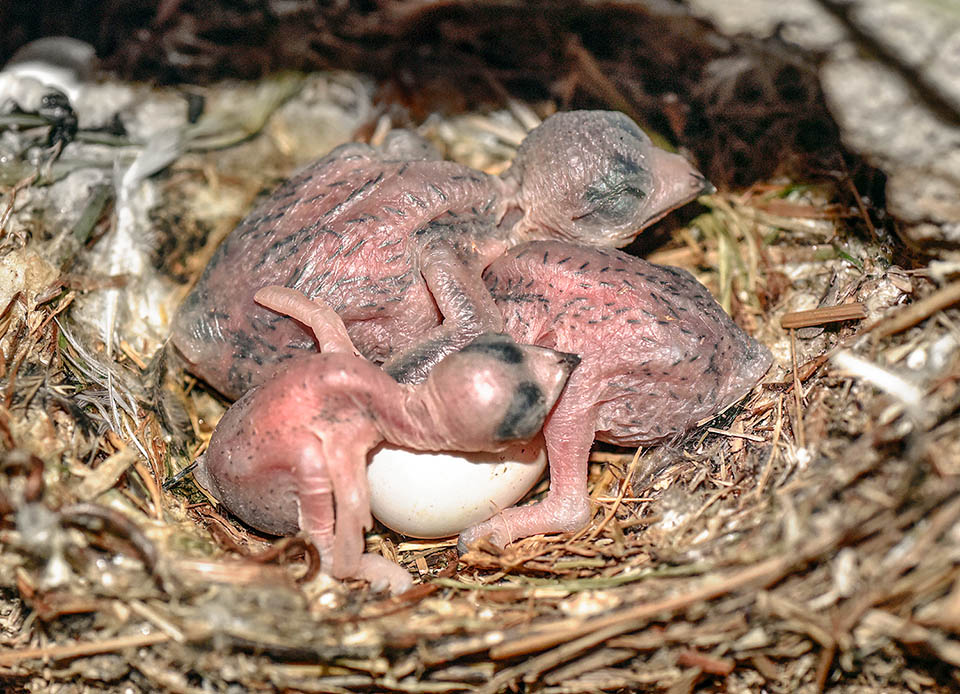
Exceptional brood with 3 newborns and one egg still to hatch. Both parents alternate in hatching © Gianfranco Colombo
After studies made by some scientists, it seems that the common swifts are able to beat the individual wings at different speed, so to create a differential effect and so to act directly on the trajectory in help of the tail. In the Anglo-Saxon world they often called it the “little black devil”, because of its way of flying in compact groups around the buildings and churches where they placed the nest, shouting madly.
Morphophysiology
The wings are a morphological peculiarity immediately evidenced by this bird. Two very narrow and long appendages that beaten violently in the air, are able to develop absolutely uncommon speeds. It even appears that the power developped by these limbs is helped by some other mechanism that implements the aerial outcomes of this bird. It is unthinkable how much power and speed are caused by such a small mechanism, so much that after all the wing beat is not so rapid, to much to be noted with the naked eye and at times even with movements beaten like in slow motion.
The Common swift is completely matt black, with the only variant of the whitish chinstrap. There is no sexual dimorphism. When flying it is easy to distinguish it from any other similar rightly due to this black colour and of course for the high speed done by the flight. In the Mediterranean area it can be often mistaken with the above mentioned Pallid swift that actually has a perfectly similar livery but just a little paler and tending to brown. Definitely a distinction not easy to do on the field! Also in the dimensions the wingspan is striking as it exceeds the 40 cm with peaks in the adults close to the 42 cm. The length is of 17 cm and the weight varies from 45 to 50 g.
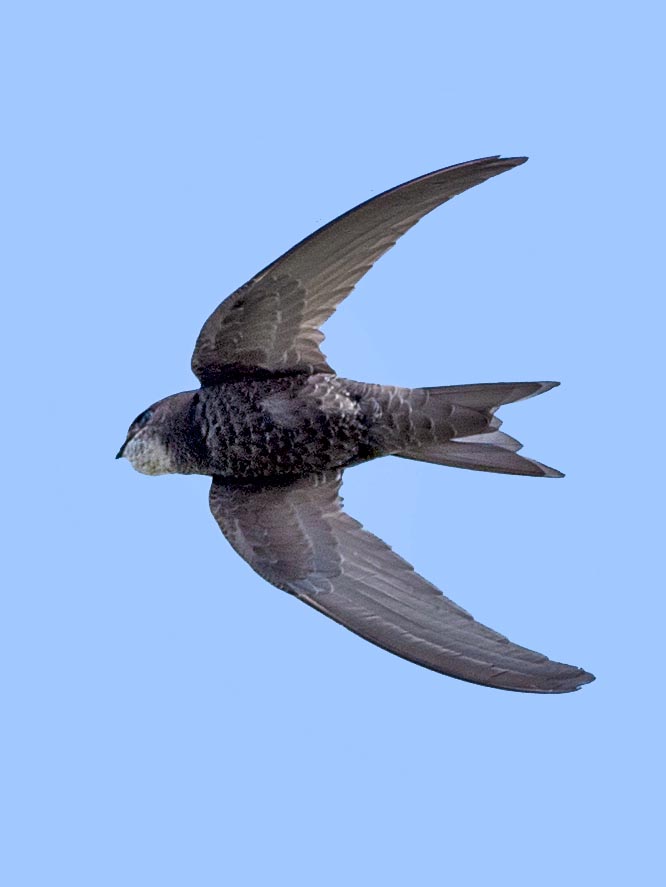
It’s easy to see, even with naked eye, specimens with the chinstrap swollen with food returning to nest © G. Colombo
The beak is very short but hides an immense mouth that, like a sack, is used for catching the flying insects. Like all swallows and swifts, these birds have a buccal sack that allows them to collect a huge number of preys and to carry them to the young from long distances. While observing them flying we can often see these bulges of the chinstrap, however of white colour, that may contain hundreds of small insects.
The tail is short and strongly bi-forked when open and is formed by 6 pairs of rectrices. The legs are very short and never visible, apart when approaching the nest, they cling with the very strong nails to the wall to enter the chosen hole.
The fingers are zygodactylic as they have the two external ones opposable to the other two, like the woodpeckers and the parrots, therefore suitable for clinging to whatever wall. So much short legs that they would inhibit to any falling specimen or that accidentally would rest on the ground, to resume the flight.
Actually, one of the most frequent causes of death of these small birds, is the fall from the nest during the phase of taking off of the young. In this case, the young would not even be nourished, not only for the awareness typical of the parents that nothing could be done but also for the danger that the parents themselves would meet while trying to reach it on the ground. The very short legs would not allow to raise the body for taking off and the extremely long wings would beat uselessly on the ground.
Ethology-Reproductive Biology
The Common swift lays the eggs only once per year and this moment is the only one it spends touching the ground. We might think that the love for the flight makes it forget the necessity of nesting, seen that also during the nesting weeks the obligation to return to the nest is strictly limited to the urgent needs of the progeny.
It is chosen a crack or a tile or a hole in a wall of a building or even a nest box or, quite occasionally, the trunk of an old tree. At times it chooses also the holes of the drains of the road buttresses even if they may transform, with a certain frequency, in real hydraulic traps. The important thing is that there must be an even minimum internal capacity for hosting even if uncomfortably, a hatching bird and the two usual babies that will come to life.
The nest is often in colonies of some tens of couples at times isolated, due to logistic and space needs, by some tens of metres but the life in common during the normal daily functions is always guaranteed. On the other hand, common swifts have never been seen flying singly but always in groups united and well together as is typical to the group social life.
The nest is formed by material collected while flying and glued with saliva to form a small oval cup. They are usually soft feathers, dry blades of grass, pieces of various material: all what can be transported by the wind. For some aspects, the nest could be compared to that of the Salangan swallow of Far East, those so famous and so much tasty nests used for preparing rightly the “nests soup”.
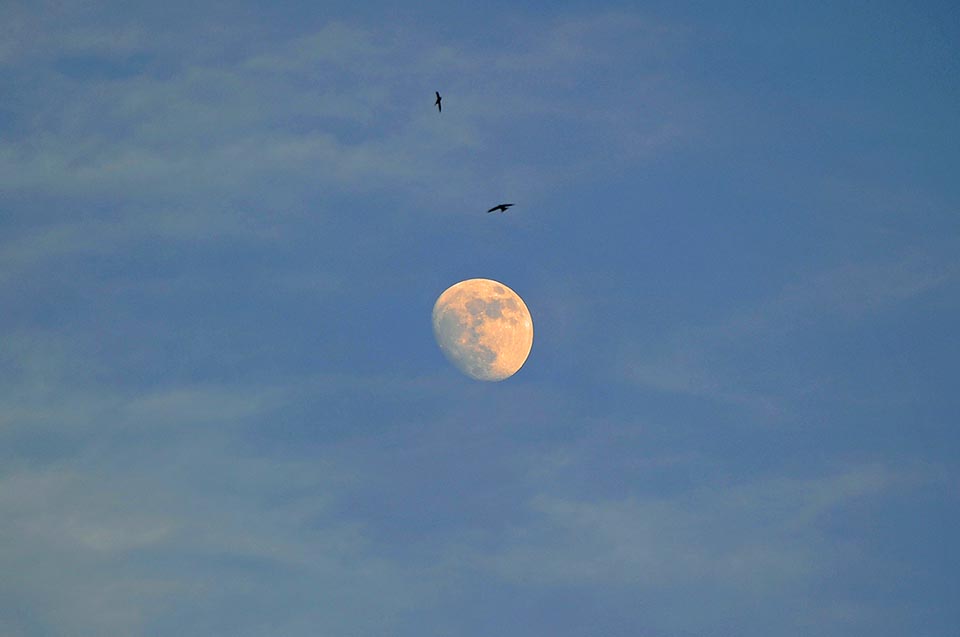
These birds eat, drink, mate and sleep while flying, as here in the moonlight © Gianfranco Colombo
Usually are laid 2 eggs, at times 3 and exceptionally 4, hatched by both parents for about three weeks. Sometimes during the time of the brood and in particular by night, the parents remain in the nest lovingly keeping each other company, as if they were waiting for the birth of the babies, but as soon as the day approaches, one of them flies off leaving the partner alone until the time of the changeover. The duration of the hatching is of about 20 days, but the stay in the nest of the young is rather long and at times even six weeks will pass before the young fly off. As a matter of fact, the operation of the take off is the most dangerous moment of their life!
Let us imagine a bird with very long wings restricted inside a narrow hole together with one or more brothers, where they can be hardly able to move and turn and where is impossible even the simple operation of stretching the wings and testing them for the flight as all nestlings do for long time before leaving the nest. Furthermore, the placing of their shelter, in narrow and strait fissures placed at usually high heights but at times at very few metres from the ground so much of not having the possibility of jumping out and test even for one single moment the functionality of that exceptional tool the nature has given them.
Difficult to manage wings if not through a mastery they had no way to test and that only in that moment they must be able to manage. One moment, a very short period of time that marks for ever their life: an error would be fatal and a fall on the ground would not give any possibility of remedy. Or good at first sight or it is over!
Synonyms
Hirundo apus Linnaeus, 1758.
